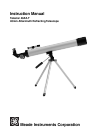
– 5 –
INTRODUCTION
This manual details the set up, operation, specifications, and optional accessories of the Telestar 40AZ-T
(40mm) Altazimuth Refracting Telescope. The Telestar 40AZ-T is an easy to operate, refracting telescope
designed for both astronomical and terrestrial observing. In order that you may achieve maximum utilization
of the instrument, we urge that you to take a few minutes to read all of this manual before making first
observations through the telescope. As you read through this manual, the technical terms associated with
telescopes will be made clear.
STANDARD EQUIPMENT (Refer to Fig. 1)
• Complete optical tube (objective lens diameter = 40mm; focal length = 600mm)
• 25mm (25X), 6mm (100X) eyepieces (.965" O.D. “Outside Diameter”)
• Diagonal mirror (.965" O.D.)
• 2X viewfinder with bracket
• Table-top Altazimuth mount
INSTALLATION:
1. Unfold the tripod (6, Fig. 1) and place the optical tube (1, Fig. 1) on top of the tripod. Then adjust the
attachment screw (10, Fig. 1) to tighten (to a firm feel) the optical tube to the tripod.
2. Attach the viewfinder bracket (13, Fig. 1) to the optical tube (1, Fig. 1) with the eyepiece cup (14, Fig.1)
pointing to the back, toward the telescope eyepiece (see diagram). Adjust the viewfinder as you are
tightening the bracket so that it points in the same direction the optical tube is pointing.
3. Slide the diagonal mirror (3, Fig. 1) into the tube and tighten the thumbscrews to a firm feel to hold in place.
4. Place an eyepiece (7, Fig. 1) into the diagonal and tighten the thumbscrews to a firm feel to hold in place.
TO ACHIEVE A CLEAR AND SHARP FOCUS:
1. Place the telescope on a stable desk or platform.
2. Do not focus through window glass; this will result in an unclear image. View an object that is at least
50 meters or more distant.
3. Make use of the altitude control handle (5, Fig. 1) and the viewfinder (2, Fig. 1) to help locate an object
to view.
4. Look through the eyepiece (7, Fig. 1) and rotate the focus knob (4, Fig. 1). Turn the knob with a slow
and gentle motion.
5. Take your time and enjoy.
USING THE TELESCOPE
With the telescope assembled as described above, you are ready to begin observations.
1. First decide on an easy-to-find object. Land objects during the daytime are a good way to become
accustomed to the functions and operations of the telescope. At night, try observing the Moon first, if it
is visible, or a bright star.
2. To center an object in the main telescope, first use the viewfinder to sight-in the object you wish to
observe. When the object is centered in the viewfinder, it should then, also, be somewhere in the main
telescope’s field of view. Next, using the 25mm eyepiece, center the object in the main telescope’s field
of view, and sharply focus the image by turning the focus knob (4, Fig. 1).
The 25mm eyepiece included as standard equipment is the best eyepiece to use for the initial finding
and centering of an object. The low power 25mm eyepiece presents a bright, wide field of view, ideal
for terrestrial and general astronomical observing of star fields, clusters of stars, nebulae, and galaxies.
For lunar and planetary viewing, switch to a higher power eyepiece such as the 6mm–conditions
permitting. If the image starts to become fuzzy as magnification is increased—back down to a lower
power—the atmosphere is not steady enough to support higher powers.
3. If you are observing an astronomical object (the Moon, a planet, star, etc.), you will immediately notice
that the object is in a rather slow but continuous motion through the telescopic field of view. This motion
is caused by the rotation of the Earth on its axis which results in an apparent motion of the object in the
telescope’s field of view;
i.e. although the Moon, planets and stars are, for practical purposes, fixed in










